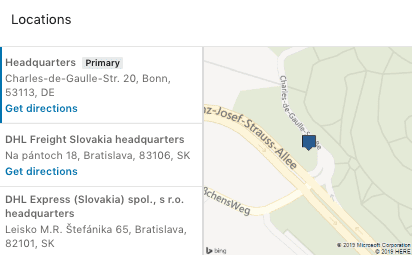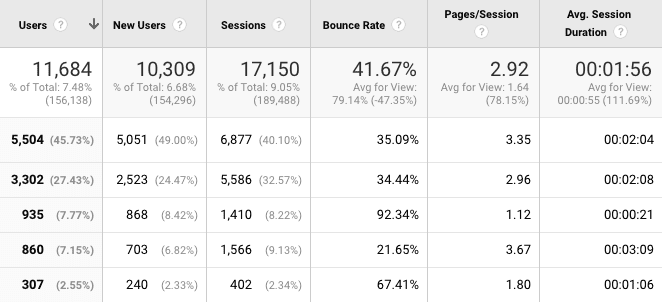Whether you’re going through a rebrand, developing a new digital strategy or investing in one for the first time, it’s safe to say that social media will have a part to play.
Before you start to implement your Social Strategy, there are a number of things you will need to consider and our checklist below will help to get you started.
1. Review Your Current Social Setup
You can’t create a strong strategy without having a strong foundation to build upon.
Whatever networks you’re focusing your efforts, make sure your social bios are all up to date.
It might sound obvious, but you’d be surprised how often it is overlooked.

Update all of your locations and contact details. Depending on the size of your organisation, you may have multiple social pages to edit.

Make sure all links are up to date and pointing to the correct pages. I’ve seen this on numerous occasions, particularly when there are a number of older pages that have been forgotten about. Maybe there was a previous subdomain used for a specific area of the business that’s no longer in use, but has now merged under the parent domain or simply non-existent anymore.
Use consistent and “on-brand” imagery across all networks for your profile images and wallpaper. There may be variants of your logo that have evolved over time, so make sure everything is consistent and in line with your current strategy.
2. What have you learned from previous efforts?
It’s important to assess what has been working up until now. Analysing the performance of previous strategies & tactics is essential. This can involve collating a lot of numbers if there is a lot of historical data, but it is worth the effort. Diving down and getting dirty with your data will pay dividends when done correctly.
Being critical of your efforts can be difficult, especially for smaller organisations, as there can be an emotional investment. The numbers don’t lie, but it is important to remember the overall objective. Here are a few questions you should look at answering to help you understand performance to date.
What content has been getting the most engagement?
Review all of your previous posts and ads across all your networks. You should start to see some sort of a trend. What posts did people like, comment on or share?

What content has been driving the most traffic to your website?
Similar to above, analyse the posts and ads that drove the most traffic to your site. Depending on the content, you may start to notice some differences between content that is good for overall brand awareness and content that is better at driving traffic….and hopefully conversions.

What messaging has been engaging audiences?
From the data already collected, you could dive down a little deeper to assess was there particular messaging that differentiated those that performed well and those that didn’t. Was it the tone of voice or a particular call-to-action.
Which media is most effective? Images, Video, Blogs etc.
Were there particular media that performed better than others? Did your video posts have better engagement than static images? It is important to be honest with yourself as well. Has your media creation up until now done your brand and product offering justice? Did enough thought go into it? You may have tasked the new intern with creating a video for an ad-hoc campaign, and it never lived up to everyone’s expectations. If this is the case, don’t let it deter you from video content.
It doesn’t have to cost a fortune or need a full film crew, but it does need time to plan and to execute correctly. If the recent trends are anything to go by, then you should be investing in video content. According to a report by Cisco, by 2020 82% of both business & consumer web traffic will be from video content. Focusing solely on the benefits of video in your social strategy – video generates 1200% more shares than text and images combined.
3. Who are your audiences?
This question can sometimes cause divide…hopefully not too much. As an established organisation you will have a lot of existing customer data you can assess.
“Differentiating your audiences is crucial. When you start to create your messaging, you’ll need to tailor it to each audience”
You may have a CRM which has a wealth of information on who your existing customers are. You may have existing intelligence from previous market research initiatives. Use this! You could start to see clusters of information that make up several audience groups. Differentiating your audiences is crucial. When you start to create your messaging, you’ll need to tailor it to each audience.
Not all businesses have to a CRM database. Either way, you should be diving into your analytics (and layering this on top of your CRM data if you have can). I’m a big advocate of combining as many data sources as possible.
Use Google Analytics to give you insight into demographics, locations, devices, referrals, interests etc. Combine this with your social analytics data. If you have advertised previously, you could break down the various targeting attributes of the ads that performed best. Dive into this further to see what pages these users like as well.
Sometimes this is just a reaffirming exercise if you feel you have a good grasp on who your target audience is, but you can find some golden nuggets from time to time.
If you don’t have a lot of historical data, you can play around with insight tools based on the knowledge you have obtained, and start getting creative. Combining both cookie-based and user-based data can give you a bit more clarity. Rather than relying on a single data source.

4. What Social networks should we invest in?
It’s easy to dive straight in and start creating profiles across as many networks as possible. After all, you need omnipresent in an omnichannel world, right? Using your audience research, you should have a better idea of where they like to hang out. If you have been active on numerous networks already, assess which ones have been driving the most traffic or have contributed the most conversions. If you have enough data in analytics, you should be able to get some clarity on this.
Your product offering or service will also play a part in this decision. Perhaps your target market is young, but maybe Snapchat isn’t the best platform to consume your content. It also could be simply down to resources. Do you have the team, the time and the content to publish across all the platforms you’d like?
5. What are your competitors doing?
It goes without saying, but it’s important to be aware of what your competitors are doing. It’s not about following their shadow. It’s about taking note of what they’re doing or more importantly what they are not doing. You can both be on Instagram and Facebook, but using their advertising features completely differently. For example, rather than showcasing your product lines in a carousel ad, why not offer an immersive experience with Instant Experience ads. Bring those potential customers on a journey, rather than showing them static images that they’ll forget by the next ad.
Better yet, why not bring that customer-centric, personal marketing approach up a notch and start using chatbots in your Facebook ads.
6. What are your goals? What should you be measuring?
Your social marketing goals should be aligned with your overall business goals. These goals can vary greatly depending on your product or service offering, the industry you operate in, competition etc.
Goals can be split between Branding and Revenue-based. In many cases, you will be combining both. Of course, you will want to see a positive ROI and ROAS, but you will want to see your brand grow.
Examples of Branding-based goals include;
- Awareness
- Sentiment
- Loyalty
Examples of Revenue-based goals include;
- Sign-ups
- Leads
- Sales
Now that you’ve decided on what goals align best with your overall marketing objectives, you need to decide what metrics you should be analysed in order to measure success. One thing to note is that you will more than likely be analysing data from multiple data sources. For example, Google Analytics and Facebook. There can be discrepancies when comparing both data sets. Google Analytics by default will report last non-direct, while Facebook’s UI will be solely reporting on Facebook data. In other words, Facebook will report on a conversion, even if the user interacted with one of your search ads after the initial social interaction. Make sure you’re set up correctly for this otherwise your numbers won’t add up.

Some basic metrics you will be most likely analysing will include;
- Reach – The number of users that saw one of your ads. It’s a great way of measuring awareness.
- Engagements – These can be anything from Likes, Shares and Comments.
- Traffic – Number of sessions, number of new users and bounce rate.
- Revenue metrics – sales, leads, Cost per Acquisition (cost per sale, cost per lead etc). ROAS is hugely important in an ecommerce setting.
If you are tracking sales or other conversions, you should also be mindful of the attribution windows that are set up. For example, will you be giving a 30-day attribution window to Facebook ads or 7 days? This will depend on the complexities of your overall campaigns.
When analysing the performance of your campaigns you want your data to tell a story. Understanding this story will help you understand your audience, understand what worked and what didn’t.
Tip: To really understand your customer’s journey and to get a better insight into your marketing spend, play around with your attribution models. They can reveal some incredible insights…and in some cases justify that spend when everyone else doubted it. You will also benefit by ensuring your channel groupings are customised so that everything can be tracked and measured as accurately as possible.
7. What are your capabilities? What’s your capacity?
Now that your research is done, and the foundations are laid, you’ll probably start having a few ideas on the approach to your strategy. You need to be realistic. You may have the passion and the determination to get it started, but does your team mirror this? Are the time, resources and skill-set available?
Before you go getting budget sign-off, you need to factor in content creation. You may have a hefty monthly advertising budget to spend, but do you have the content to stand-out and get noticed in a user’s, already saturated, feed? Your targeting may be close to perfect, but if your content isn’t, then the horse may fall flat before even reaching the water.


